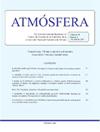unam液滴冻结试验:热带和亚极地水域海洋表面微层和表面混合层冰成核能力的评估
IF 1
4区 地球科学
Q4 METEOROLOGY & ATMOSPHERIC SCIENCES
引用次数: 3
摘要
大气中的冰核粒子(INPs)是混合相云中产生冰晶的必要条件,是降水发展的关键组成部分。imp的来源和组成各不相同:从大陆侵蚀产生的矿物粉尘到导致海洋表面气泡破裂的生物气溶胶。自制液滴冷冻测定(DFA)装置的性能通过浸入式冷冻对水样的冰核能力进行了量化,并对来自墨西哥湾(GoM)和Saanich Inlet的海面微层(SML)和散装地表水(BSW)的样品进行了分析,这些样品来自加拿大温哥华岛(VI)。即使在没有浮游植物大量繁殖的情况下,所有样品都含有中等浓度的冰核颗粒,范围从6.0 × 10 1到1.1 × 10 5 L -1水。样品的冻结温度(即50%液滴冻结时的温度t50)依次为VI SML > GoM BSW > GoM SML,表明高纬度沿海水域具有更大的引发云和降水的潜力。本文章由计算机程序翻译,如有差异,请以英文原文为准。
The UNAM-Droplet Freezing Assay: An Evaluation of the Ice Nucleating Capacity of the Sea-Surface Microlayer and Surface Mixed Layer in Tropical and Subpolar Waters
Ice nucleating particles (INPs) in the atmosphere are necessary to generate ice crystals in mixed-phase clouds, a crucial component for precipitation development. The sources and composition of INPs are varied: from mineral dust derived from continental erosion to bioaerosols resulting bubble bursting at the ocean surface. The performance of a home-built droplet freezing assay (DFA) device for quantificatying of the ice nucleating abilities of water samples via immersion freezing has been validated against both published results and analyses of samples from sea surface microlayer (SML) and bulk surface water (BSW) from the Gulf of Mexico (GoM) and Saanich Inlet, off Vancouver Island (VI), Canada. Even in the absence of phytoplankton blooms, all the samples contained ice nucleating particles at moderate concentrations, ranging from 6.0x10 1 to 1.1x10 5 L -1 water. The freezing temperatures (i.e., T 50 , the temperature at which 50% of the droplets freeze) of the samples decreased in order of VI SML > GoM BSW > GoM SML, indicating that the higher-latitude coastal waters have a greater potential to initiate cloud formation and precipitation.
求助全文
通过发布文献求助,成功后即可免费获取论文全文。
去求助
来源期刊

Atmosfera
地学-气象与大气科学
CiteScore
2.20
自引率
0.00%
发文量
46
审稿时长
6 months
期刊介绍:
ATMÓSFERA seeks contributions on theoretical, basic, empirical and applied research in all the areas of atmospheric sciences, with emphasis on meteorology, climatology, aeronomy, physics, chemistry, and aerobiology. Interdisciplinary contributions are also accepted; especially those related with oceanography, hydrology, climate variability and change, ecology, forestry, glaciology, agriculture, environmental pollution, and other topics related to economy and society as they are affected by atmospheric hazards.
 求助内容:
求助内容: 应助结果提醒方式:
应助结果提醒方式:


